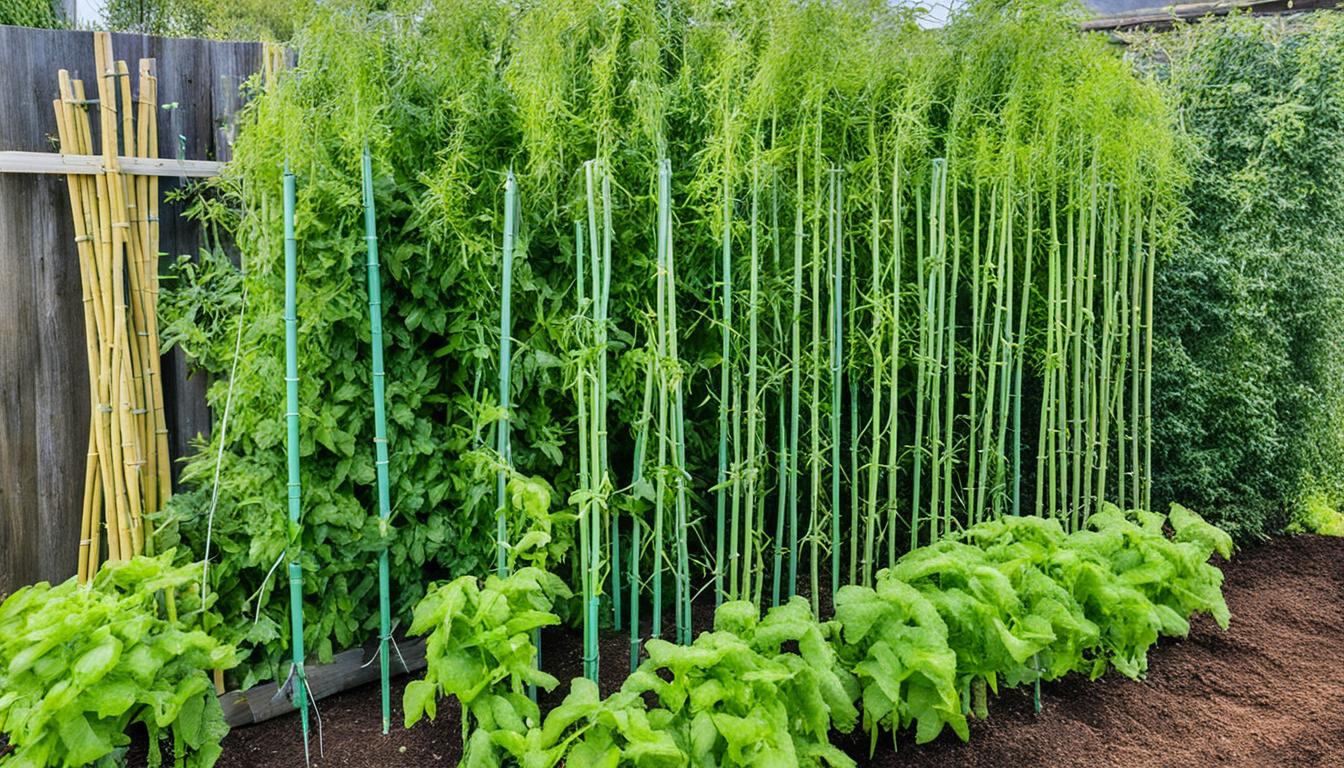Wondering what all you need to stake tomato plants? Staking tomato plants is key for a great harvest. You’ll need the right tools from sturdy stakes to special ties to succeed. Choosing the best supplies ensures your tomatoes grow healthy and strong.
So, what are the essential supplies needed for staking tomato plants? The list includes:
Tomato Stakes: You’ll need sturdy stakes for support. Ideally, choose ones that are 2 inches square and 4 to 7 feet tall. Make sure to pound them at least 15 inches into the ground and bury them 1 foot deep to support mature plants well.
Plant Ties and Clips: Use soft ties, Velcro, or clips to secure your tomato vines to the stakes. This helps as your plants get taller.
Pruning Tools: It’s important to have shears or scissors for pruning. Regularly cutting away suckers helps air flow around the plant and reduces disease risk. Keep your plants strong and healthy with this step.
Other Gardening Essentials: Don’t forget gloves, a moisture meter, mulch, a drip system, compost, and fertilizers. These items boost your plants’ health and fruitiness when used with your tomato staking setup.
Staking your tomato plants in the right way is essential for plentiful harvests. But why do it? Staking has several important advantages. Let’s dive into these benefits.
Key Takeaways
- Tomato plants require sturdy support structures to keep them upright and maximize yield.
- Essential supplies for staking tomatoes include stakes, plant ties, pruning tools, and other gardening accessories.
- Staking tomato plants helps prevent disease, improve accessibility, save garden space, and enhance overall plant care.
- Choosing the right support system and materials is crucial for a successful tomato harvest.
- Proper staking and pruning techniques can improve air circulation and plant health.
Why Stake Tomato Plants?
Tomatoes like to move all around. They grow upside down, sideways, and up. But, why put support structures around them?
To get it, you have to know this. Tomato plants and what you want as someone who eats tomatoes are different.
Prevents Disease and Fruit Rot
To the plant, growing and reproducing are big deals. It just needs the earth and it’s good. But for you, the goal is to pick those fruits first.
Cages and trellises help you do that. They keep the fruits away from the ground. This stops disease and rot, making more of your harvest good to eat.
Improves Accessibility and Pest Control
Keeping tomatoes off the ground means two things for you. It makes checking for pests and diseases easier. Plus, picking the fruit without harm becomes a breeze.
Saves Garden Space
Staking your tomatoes saves space. They can grow upwards instead of sprawling. This lets you grow more in the same area.
Enhances Plant Care
Staking provides more than just support. It can help the plant stay healthy and stable. Supported plants are safer from the wind and other harm.
Determinate vs. Indeterminate Tomato Varieties
Know the difference between determinate and indeterminate tomato types is key. It helps pick the right stakes and supports for your plants.
Determinate Tomato Types
Determinate tomatoes grow about 4 feet tall. They give one big harvest in about two weeks. San Marzano Nano’, ‘Amish Paste’, ‘Marglobe’, and ‘Rutgers’ are popular kinds.
Indeterminate Tomato Types
Indeterminate tomatoes can be as tall as 12 feet, but usually around 6 feet. They keep making fruits all season. ‘Beefsteak’, ‘Big Boy’, ‘Brandywine’, ‘Sungold’, and ‘Sweet Million’ are well-known.
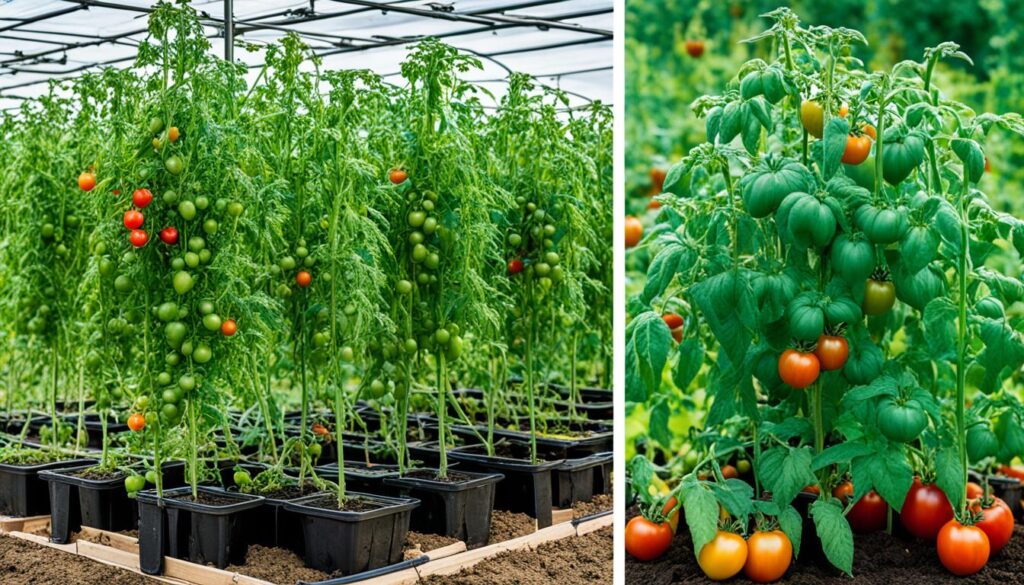
It’s vital to know how determinate and indeterminate tomatoes grow. This knowledge helps you support your plants well. With the right care, everyone can get lots of tasty tomatoes throughout the year.
Single Stake Support System
A single stake helps tomato plants stay straight in small spaces. Around 80% of tomato plants use stakes or other support. This keeps them and their fruit off the ground for a better harvest. For staking, use a 5-foot stake for determinate types and an 8-foot one for indeterminate kinds. Stakes are a wallet-friendly choice but need regular plant support during the growing season. The stakes should be at least 4 feet tall.
Stake Height and Material
Sink the stake about 4 inches from the plant’s base and 12 inches deep in the soil. The right depth ensures it can hold the plant’s weight when it fruits. This method is a cheap and simple way to support tomatoes in small or city gardens.
Tying Techniques
Use fabric strips or soft, stretchy ties to gently tie up the plant as it grows. Tie the plant every 6 to 8 inches up the stake. Keep every tie 1 inch above where there are flowers. This prevents the ties from hurting the plant as it bears fruit.
Pruning for Single Stake Support
For a single stake, prune the tomato plant to have one main stem. Take off any other branches that might grow. This way, the plant puts its effort into making bigger, better fruit. Pruning and staking together help you get more from your small garden.
Supplies needed for staking tomato plants
Staking tomato plants requires the right tools for a great harvest. You’ll need sturdy stakes, plant ties, pruning tools, and more.
Various types of tomato stakes are available. This includes wooden, metal, or bamboo. For tomato cages, use sturdy wire or metal ones. They help support your tomato plants.
Aside from stakes and cages, you’ll need twine, ties, or clips to attach plants. Pruning shears and gardening gloves are vital too. They help with staking and care.
More necessary supplies are a hammer to set stakes, plant labels, and a moisture meter. Mulch, compost, and fertilizers help the tomatoes grow healthily.
With the correct equipment, you ensure your tomatoes grow well. This way, you’ll have plenty of tomatoes for the whole season.
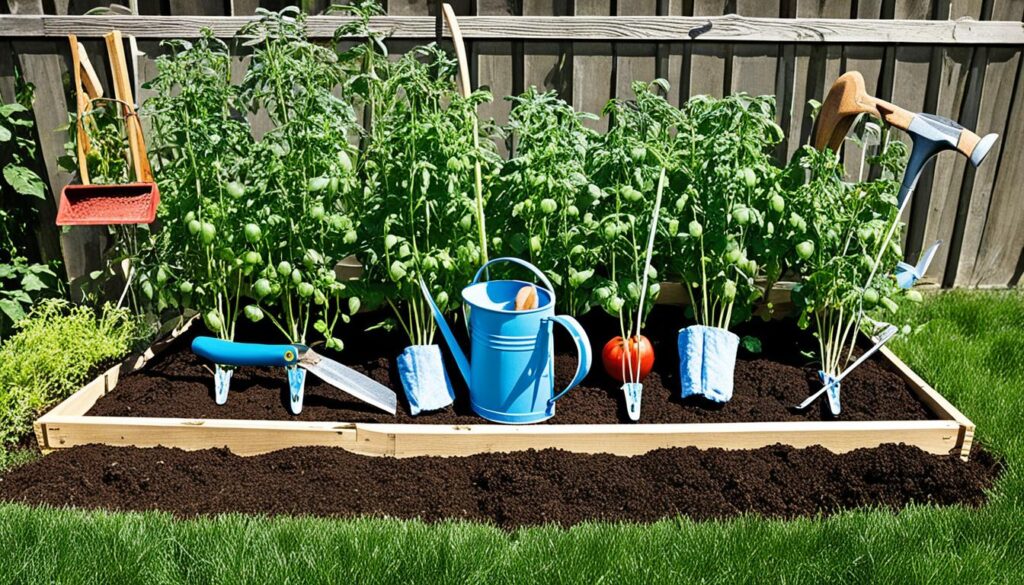
| Item | Description |
|---|---|
| Tomato Stakes | Sturdy wooden, metal, or bamboo stakes in varying heights to support plants of different sizes. |
| Tomato Cages | Wire or heavy-duty metal cages that can be set up around the plants to provide structure and support. |
| Plant Ties and Clips | Soft, stretchy materials used to gently attach the tomato plants to their support structures. |
| Pruning Tools | Shears, scissors, and other tools for trimming and maintaining the plants. |
| Gardening Accessories | Hammers, mallets, plant labels, moisture meters, mulch, compost, and organic fertilizers. |
Tomato Cages
Wire tomato cages are very common for supporting tomatoes. But many people find them weak. They work well when the plants are small but may fall over with big fruit. To make them stronger, use metal stakes. Put them deep in the ground next to the cages. Then, tie the cages to the stakes.
Wire Tomato Cages
Many gardens use wire tomato cages for their tomato plants. The problem is, these cages are often not strong enough. They might tip over in the wind. To fix this, add stakes and tie them to the cages. This will help keep your tomato plants standing tall.
Heavy-Duty Tomato Cages
Another option is to buy heavy-duty tomato cages. They are made of stronger materials and can hold more weight. While they might be more expensive, they offer better support. This can help your tomato plants grow better.
Reinforcing Tomato Cages with Stakes
If you have wire cages already, adding stakes can help a lot. This method keeps the cages steady, even in wind. You could also create strong cages yourself. Use materials like concrete wire mesh. This way, your tomato plants will stay in place all season.
Basket Weave Support System
The basketweave tomato support method is great for staking tomatoes. It also creates a hedge-like look. It’s perfect for six or more tomato plants in one row. Make sure they are about 24 inches apart. Then, weave strong twine through the plants every week or two. Do this until the plants are at the top of the stakes.
Setting Up the Basket Weave
Start by placing 5- to 7-foot-tall stakes in the ground. They should be 12 inches deep, between each plant. These stakes make the framework for the weaving. Plants should be 18 to 24 inches apart. This depends on the soil and the type of tomato. For loose, sandy soil or smaller plants, you can put them 18 to 21 inches apart. But for dense soil or bigger plants, they should be 21 to 24 inches apart.
Weaving Technique
After putting up the stakes, start weaving twine through the plants. Loop it around each stake. You should do this every week or two as the plants grow. It creates a basket-like support. Keep the twine tight for good plant support. But don’t make it too tight that it’s hard to harvest the tomatoes.
The basketweave method is great for growing more tomatoes in a small space. It makes a well-supported tomato hedge. This can help you get more tomatoes and use your space efficiently.
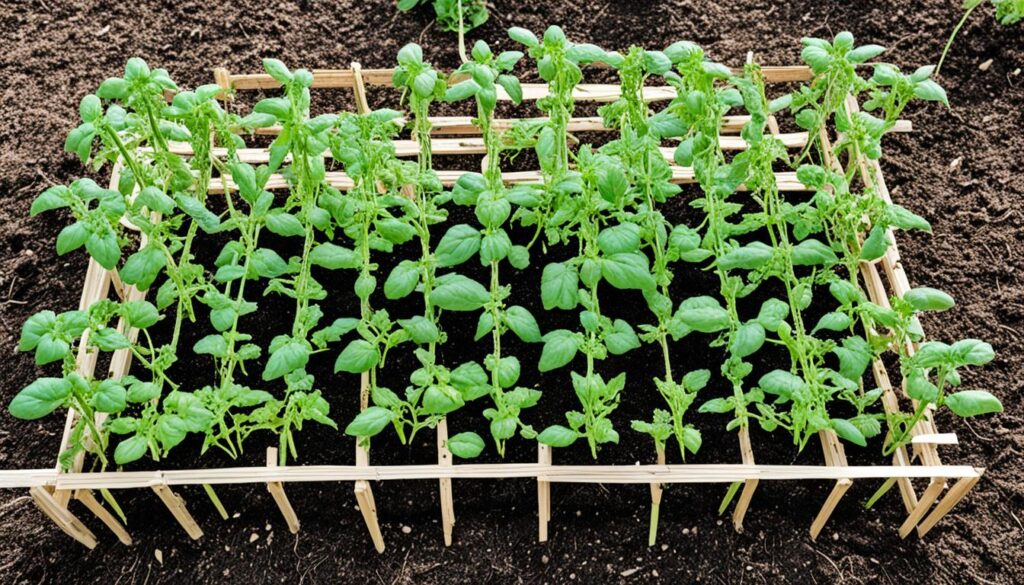
Trellis and Twine Support
Farmers and advanced gardeners often train their tomatoes to a single vine to get more tomatoes. The system can be costly and time-consuming but pays off well during harvest. In this method, plants are held up by both wood stakes and twine strung between the stakes.
Vertical Trellis Systems
Professional greenhouses and skilled horticulturists commonly use string training. Tomatoes in this method grow either with one main stem or two main stems. Heirloom tomatoes are great for these systems since they can grow very tall, up to 10 feet high. Hybrid tomatoes, on the other hand, are usually shorter, around 5 feet. Growing tomatoes upwards, using strings, makes the best use of space and air flows better, reducing disease risks. The French Pruning Method is a technique that keeps only one stem with leaves for better growth.
Horizontal Trellis Systems
For string training, it’s best to use a synthetic string that doesn’t stretch; it lasts long. Use cotton clothesline of ¼”, 7/32″, or 3/16″ for sturdy support through different weather conditions. To secure the trellis, landscape staples are commonly used, but wrapping the string around the plant’s stem works too. Remember, when pruning, never cut more than 25% of the plant’s leaves at once to keep it healthy.
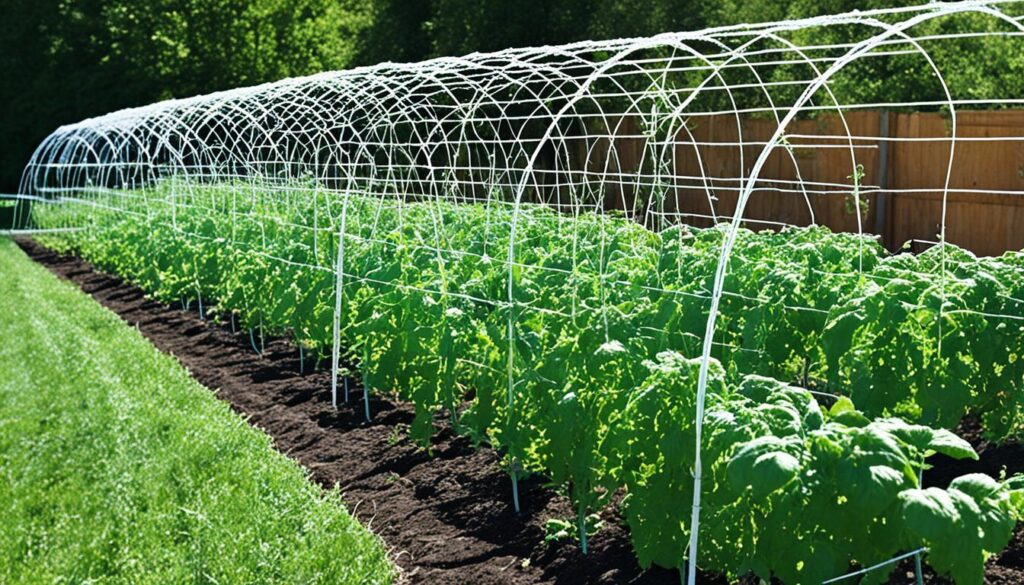
Plant Ties and Clips
Staking tomato plants needs the right tools. Plant ties and clips help safely attach them to supports. Use soft fabric or stretchy vinyl to tie stems to stakes. Place the ties 6 to 8 inches apart. This way, plants can move and grow freely.
Soft Plant Ties
Tomatoes love soft plant ties. These ties are made from fabric, rubber, or vinyl. They won’t harm the plant’s delicate stems. Just wrap the tie around stem and support, leaving some slack.
Velcro Plant Ties
Velcro plant ties are also great. They can be used again and again. You can easily change how tight they are. They’re ideal for tying plants to poles, cages, or walls.
Tomato Clips
Tomato clips are special for quick and secure tying. Made of plastic or metal, they snap onto stem and support. They hold the plant well but let it grow freely. This is good for plants that need a lot of care and moving.
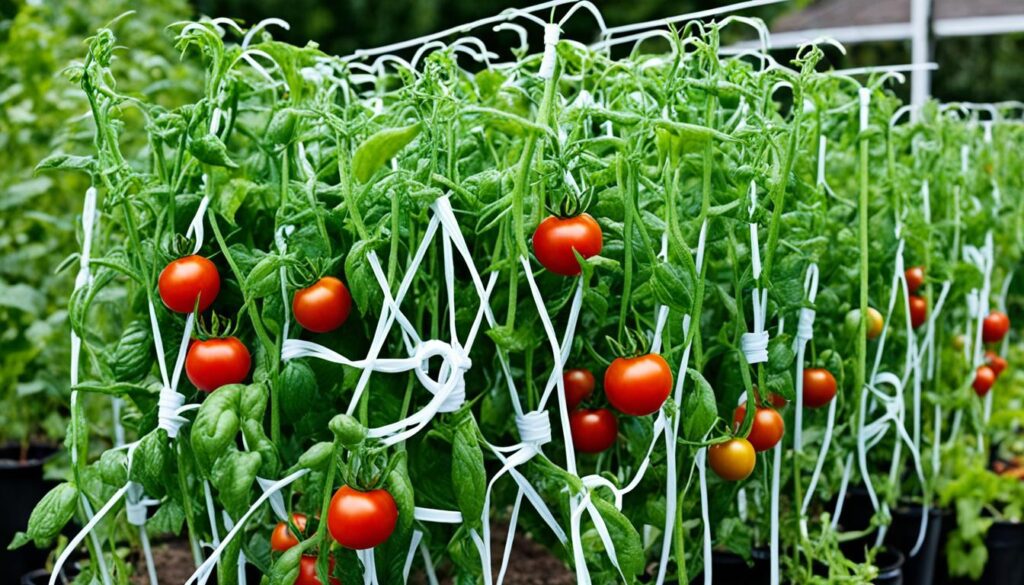
Conclusion
Staking tomato plants helps grow more and healthier tomatoes. You can use a single stake or a big trellis. This gives your plants the right support. It helps them produce more fruit and stay healthy. Knowing if your plants are determinate or indeterminate helps you choose the best staking method.
You can use metal stakes that last or try the Florida weave method. Tomato cages can also support your plants. Adding ties in the right places helps too. Pruning and thinning the fruit boosts benefits.
This improves air flow, cuts disease risks, and makes your plants stronger. With the right work, your tomato garden can bloom. It will give you lots of tasty tomatoes each year.
By spending some effort on staking, you can have the best tomatoes. Start today. Check out the resources. They can guide you on staking for your space and plant types.
FAQ About Staking Tomato Plants
What are the essential supplies needed for staking tomato plants?
You’ll need sturdy stakes or supports. Also, get plant ties or clips. Don’t forget pruning tools. You will use other items too, like garden twine, tomato cages, trellises, and mulch.
Why is it important to stake tomato plants?
Staking your tomato plants has many benefits. It helps avoid disease and fruit rot. It also makes pest control and harvesting easier. This saves space in your garden and makes your plants healthier.
What is the difference between determinate and indeterminate tomato varieties?
Determinate tomatoes grow to a certain size and give fruit all at once. Indeterminate types keep growing and fruiting all season. Because of this, their support needs are different.
How do I use a single stake to support my tomato plants?
For a single stake, use a 5-foot or 8-foot tall stake. This depends on the type of tomato. Put it 12 inches into the ground by the plant’s base. Tie the plant to the stake as it grows.
What supplies are needed for staking tomato plants?
You need strong stakes, ties or clips, and pruning shears. Don’t forget garden twine. Tomato cages or trellises are also important. Several other tools and accessories are needed as well.
How can I reinforce wire tomato cages?
Help wire cages stay up by adding two metal stakes next to them. These stakes should be 5 to 7 feet tall. Tie the cage to these stakes. You can also make your own sturdy cages using concrete wire.
How do I set up a basket weave support system for my tomato plants?
To set up the basket weave, thread twine through staked plants every week. Keep doing this until plants reaches the stakes’ top. This system is good for six or more plants in a row.
What type of plant ties or clips work best for staking tomatoes?
Use soft fabric strips or stretchy vinyl for tying your tomato plants. These won’t harm the plants. Velcro ties and clips are good choices for tomato vines too.
Source Links
- https://www.thespruce.com/how-to-stake-tomatoes-4688635
- https://ourlittlechateau.com/2020/08/31/to-stake-or-not-to-stake-tomato-plant-questions-answered/
- https://www.thespruce.com/indeterminate-tomato-variety-1403423
- https://seedmoney.org/blog/5-ways-of-supporting-your-tomato-plants/
- http://mgsantaclara.ucanr.edu/garden-help/vegetables/tomatoes/tomato-staking-techniques
- https://freshexchange.com/are-tomato-cages-necessary-diy-tomato-cage-alternative/
- https://njaes.rutgers.edu/FS1102/
- https://www.theartofdoingstuff.com/turns-im-never-really-satisfied-anything-including-tomatoes/
- https://extension.uga.edu/publications/detail.html?number=C1150&title=staking-and-pruning-tomatoes-in-the-home-garden
